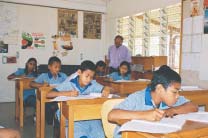Chapter 6
EDUCATIONAL STANDARDS AND
QUALITY ASSURANCE
Table of contents return to Front page
Brief History of Quality Assurance of
Sathya Sai Schools
Comparison of Sathya Sai School and
Public (Government-funded)
Education Quality Assurance
SAI 2000: Standards, Accreditation, Inspection
Standards
Inspection and Accreditation
Global Level Accreditation Process
Current Status of Quality Assurance of
Sathya Sai Schools
Future Perspectives on Quality Assurance
References
Brief History of Quality Assurance of Sathya Sai SchoolsSathya Sai Schools are subject to the jurisdictional requirements of local education ministries. In some cases, such as the Sathya Sai Schools in England, the national schools inspection process is applied to the School. Sathya Sai Schools have a unique emphasis of spiritually-based character transformation of students. This is especially so when compared to the typical private, or public (governmentfunded) schools. Because of this, the Sri Sathya Sai Organisation itself monitors the quality assurance of Sathya Sai Schools. |
Modern education develops the intellect and imparts skills but does not promote good qualities in any way. Of what value is the acquisition of all the knowledge in the world if there is no character? Knowledge has multiplied and desires have grown, with the result that one is hero in words but zero in actions. —Sri Sathya Sai Baba 
Fiji
|
Comparison of Sathya Sai School and Public
|
Character should keep pace with the advancement of intelligence.
The development of intelligence without a corresponding development of character is an exercise in futility.
—Sri Sathya Sai Baba The use of quantitative achievement test data alone can not adequately monitor the quality of instruction and environment needed to foster human values and develop positive character traits in students along with academic excellence. This is particularly so because of the subjective or reflective basis of character and its integral, inseparable relationship to human spirituality. As the eminent scientist Albert Einstein said, "Not everything that can be counted, counts. Not everything that counts can be counted" (Einstein, 1941). The concept of establishing standards for Sathya Sai Schools is therefore based on: (a) monitoring for quality by a combination of a school's self-review and a peer-review inspection visit; (b) deliberation of the results of the review process by an accreditation body; and (c) conferring of accreditation status on the school meeting the standards. 
Chili
|
SAI 2000: Standards, Accreditation, InspectionThe first initiative to monitor quality assurance of Sathya Sai Schools was undertaken in 2000 with the development of SAI 2000, an extensive standards-accreditation-inspection document. In 2002, an Accreditation Commission was established. The SAI 2000 document provided a set of standards for the operation of Sathya Sai Schools, and a description of a self-review, peer-review inspection, and accreditation process. StandardsSAI 2000 addressed five areas:
Inspection and AccreditationAfter completing the self-review documentation evaluating the school vis-à-vis the standards, the Sathya Sai School would expect a visit from an outside inspection |
What the mind thinks should be examined critically by the heart and the right decision carried out by the hand. This should be the primary product of the educational process.—Sri Sathya Sai Baba team. The inspection team comprises primarily education professionals knowledgeable about the Educare process, most of them within the Sri Sathya Sai Organisation. An inspection report is then developed and submitted to the Accreditation Commission, whose members are professional educationists also within the Sri Sathya Sai Organisation. Inspectors and Commission members represent all continents of the globe. During 2002-03, nearly all Sathya Sai Schools completed a self-review, documenting whether they were aware of the standards and supporting components, and whether the school had attempted or achieved meeting the component. In 2003 and 2004 six schools were accredited for six-year periods each following a self-review evaluation, external peer-review visit, and Accreditation Commission review of related reports addressing each school's adherence to the standards of SAI 2000. The six schools were the Sathya Sai Schools of Thailand, Zambia, Murwillumbah in Australia, New Castle, Chatsworth, and Lenasia in South Africa.The Accreditation Commission also made recommendations for improvements in each school. Global Level Accreditation ProcessThe Accreditation Commission met three times at Prasanthi Nilayam during 2003-04 to confer accreditation status on six schools and to address other global issues facing Sathya Sai Schools and Institutes. A process of global review of all Sathya Sai education programmes, including Sathya Sai Schools' quality assurance, began in late 2004. In the light of the emerging experience with the global accreditation process, it was generally agreed that the accreditation process will be delegated to regional educationists with the knowledge of the region and local languages. |
Current Status of Quality Assurance
|
The marks that students get in the examination are not true marks. True marks arise from the heart.—Sri Sathya Sai Baba Given the rapid expansion of schools over such a large region, the development of regional guidelines for quality assurance in Latin America is a work in progress. In the Institute of Sathya Sai Education in Argentina, for example, guidelines and expectations for establishing Sathya Sai Schools and teacher training are comprehensively described. An accreditation committee is part of the Institute working group there.The Brazil ISSE reports that informal qualitative evaluations of Sathya Sai Schools have shown clearer results than formal inspection visits, indicating the emerging nature of the quality assurance process. A two-member committee visited all Sathya Sai Schools and reported to the Institute, with a very positive view about the quality and management of all Schools. A member of the Brazil Institute was named as a permanent inspector and accreditation official for the five Sathya Sai Schools in the area. Each Sathya Sai School has a Permanent Supervising Board (mostly connected to the Sri Sathya Sai Organisation), independent from the School Board.The mission of the Supervising Board is to learn, support, understand, and guide in the development of the Sathya Sai School in accordance with the principles of the educational philosophy. Some of the Sathya Sai Schools follow standardised governmental tools to evaluate academic achievements, and show promising results. The ISSE in Chile indicates that the Sathya Sai School is accredited by the Chilean Ministry of Education. The ISSE in Mexico reports that there is no formal accreditation process implemented at present; however, the Sri Sathya Sai Organisation schools' inspector makes frequent visits. In other countries, such as Guatemala, Peru, Ecuador, Chile, and Paraguay there is still no SAI 2000 or equivalent accreditation process in place for the Sathya Sai Schools. However the quality of the education in each of them has been verified by the Latin America Sri Sathya Sai Organisation. The Venezuela Sathya Sai School operates under SAI 2000 accreditation, and it has its own continual process of improvement in all areas considered in SAI 2000. In Venezuela there is also an accreditation person as a member of the Fundasathya, the Sai Organisation Education Trust, which oversees the operation of the School.The School maintains high educational standards and a defined process of quality assurance; however, the Venezuela Sathya Sai School has no academic assessment comparison with other schools because the Ministry of Education has not considered such policy among the national schools. By 20062007 the Sathya Sai School will start an academic research programme to get comparable variables. Worldwide, Sathya Sai Schools adopt respective national curriculums integrated with the human values. In most cases, national curriculum assessments or inspections by respective Education Ministries complement the quality assurance system in Sathya Sai Schools. For example in South Africa, the national accreditation requirements are that all independent schools are required to undergo an accreditation process based on national standards conducted by a national body, UMALUSI. At two of the South Africa Sathya Sai Schools the national evaluation has been completed and now they will undergo an on-site visit. The other two schools are in the process of completing the self-evaluation. Chapter 8 gives examples of achievements of Sathya Sai Education programmes. In relation to quality assurance, it is common to see reports of Sathya Sai Schools exceeding their respective national curriculum assessment standards and their being viewed as model schools by public education officials. Examples include Sathya Sai Schools of Canada, Zambia, Thailand, The Philippines, Peru, and New Zealand Preschool. In July 2003, the Australia Sathya Sai School underwent an educational inspection by the New South Wales Board of Studies. The inspectors were most impressed by the school's education in human values programmes and its academic curriculum. They stated that the Sathya Sai School had achieved its goal of integrating human values into the general Australian school curriculum.The school was granted a six-year certificate, which was the maximum available. Other examples are given in Chapter 8. |
Future Perspectives on Quality AssuranceThe recent Task Force on Educare and the Ad-hoc Education Committee appointed by Sri Sathya Sai Organisation have observed that maintaining a quality assurance process is essential. The methodology of quality assurance is likely to be gradually developed within the scope of Sathya Sai Education rather than current governmental education systems. Accountability in Sathya Sai Education Programmes involves value-orientation of students, which is difficult to quantify. The methodology of quality assurance of Sathya Sai Education will continue to emerge and be refined as understanding of the Educare process grows. While the main thrust of quality assurance of Sathya Sai Education programmes has been with the Sathya Sai Schools, there is awareness that the Sai Spiritual Education (SSE) and Sathya Sai Education in Human Values (SSEHV) programmes also require a carefully considered quality assurance process. Such processes have already been put in place by the Sri Sathya Sai Organisation in the United Kingdom for SSE programmes, and by the ISSE in Australia for SSE and SSEHV programmes. |
Teaching is the noblest of professions; it is also the holiest sadhana (path) for self-realisation. For it involves the cultivation of selfless love and the showering and sharing of that love. The teacher moulds the rising generation into self-confident, self-reliant, Atma-conscious (God conscious) persons. —Sri Sathya Sai Baba 'Look up and aim high' should be the motto. Low aim is actually a crime! If a student aims at 90 per cent, he manages to get 60 per cent. If, on the other hand, he aims only at 30 per cent, he may get only 15 per cent.—Sri Sathya Sai Baba The actual syllabus is not as important as the creation of an atmosphere where noble habits and ideals can grow and fructify.—Sri Sathya Sai Baba |
References
British Columbia Ministry of Education, (2001), Accreditation program for schools, Retrieved January 22, 2002 from http://www.bced.gov.bc.ca/accreditation/
Einstein, A., (1941), Science, philosophy, and religion: A symposium. Retrieved July 15, 2002, from http://www.positiveatheism.org/hist/einsci.htm#TWO
Finn, C. E. and Kanstoroom, M., (2001), State academic standards, in: D. Ravitch (ed.),
Brookings Papers on Education Policy (pp. 131-180), Brookings Institute Press,
Washington, DC, USA.
Goldberg, M., and Traiman, S., (2001), Why business backs education standards, in: D. Ravitch (ed.), Brookings papers on education policy (pp. 75-130), Brookings Institution Press, Washington, DC, USA.
Office of Standards in Education (OFSTED), (2000), Local education authority inspections. Retrieved January 22, 2002 from http://www.ofsted.gov.uk/inspect/index.htm?http://www.ofsted.gov.uk/ inspect/lea.htm
Pais, A., (1982), Subtle is the Lord: The science and the life of Albert Einstein. Oxford University Press, New York, USA.
Ravitch, D. (ed.), (2001), Brookings Papers on Education Policy. Brookings Institute Press, Washington, DC., USA.
SAI (2000), The Quality Assurance for Sathya Sai Schools, Institute of Sathya Sai Education, Bangkok, Thailand.
U.S. Department of Education, Office of Postsecondary Education, (2001), Nationally recognized accreditation agencies. Retrieved January 17, 2002 from http://www.ed.gov/offices/OPE/ accreditation/regionalagencies.html
U.S. Department of Education, Office of Postsecondary Education. (n.d.). Nationally recognized accreditation agencies. Retrieved January 17, 2002 from http://www.ed.gov/offices/OPE/ accreditation/natlagencies.html